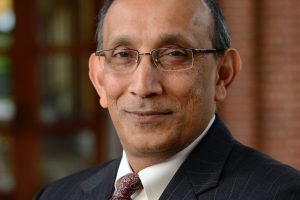K.T. Ramesh is the Alonzo G. Decker Jr. Professor of Science and Engineering at Johns Hopkins University. He was senior advisor (for AI) to the president of Johns Hopkins University, was the interim co-director of the Johns Hopkins Data Science and AI Institute, and was the executive director of the AI-X Foundry (which became the Data Science and AI Institute). Professor Ramesh was the founding director of the Hopkins Extreme Materials Institute, and is a professor of mechanical engineering, with joint appointments in materials science and engineering and earth and planetary sciences. He is a member of the Principal Professional Staff at the Johns Hopkins Applied Physics Laboratory.
He has established two major research centers and is the founding director of the multidisciplinary Hopkins Extreme Materials Institute (HEMI), which seeks to develop the science and technology to protect people, structures, and the planet. He led the Materials in Extreme Dynamic Environments Collaborative Research Alliance, a 10-year effort by a consortium of 15 universities and the U.S. Army Research Laboratory that developed physics-based approaches to materials design for armor applications.
Ramesh is one of the world’s leading authorities on impact mechanics and materials subjected to extreme conditions. He has done seminal work in discovering and modeling the mechanisms active in materials subjected to very rapid loading, through a combination of sophisticated experimental methods and physics-based theoretical and computational modeling.
His current research focuses on AI in materials design, impact biomechanics including concussions and the mitigation of traumatic brain injury, protection materials, hypersonics, the dynamic limits of life, and studies of asteroid hazard mitigation. His scholarship has had major applications in national defense, the design of protective material systems, and modeling the disruption of asteroids that could hit the Earth, including his involvement in the NASA DART impact event. He was honored for his contributions to the filed in 2023, when asteroid 32518 was officially named “Ktramesh” by the International Astronomical Union’s Small Bodies Nomenclature Working Group.
His research efforts have been published in more than 275 archival journal papers, and he is author of the book Nanomaterials: Mechanics and Mechanisms. In addition, his methods and codes have been made available in the public domain. Ramesh’s research and scholarship have been recognized through major awards from a range of professional societies, both national and international, such as the Koiter Medal from the American Society of Mechanical Engineers, the Murray Medal, the Lazan Award, and the Hetenyi Award from the Society for Experimental Mechanics, and the John Rinehart Award of the DYMAT Association in Europe. He has been elected as a Fellow of the American Association for the Advancement of Science, the American Society of Mechanical Engineers, the Society for Experimental Mechanics, and the American Academy of Mechanics. He has also held leadership roles in national professional organizations, including as president of the Society of Engineering Science and on the boards of directors for the Society of Engineering Science, the Society for Experimental Mechanics, and the American Academy of Mechanics.
Ramesh emphasizes the development of people with a breadth and depth of interests and capabilities, and this has resulted in impact across many sectors. His former mentees have gone on to become faculty at institutions of higher education across the world, principal scientists at national and international laboratories, and leading engineers in industry. He also has a particular interest in the ways in which creativity and the arts can be integrated into the sciences and engineering, and strives to integrate poetry and the arts into his teaching, his research, and his leadership.
Ramesh received his undergraduate training in mechanical engineering, while his graduate work at Brown University was in solid mechanics and applied mathematics. He joined Johns Hopkins University as an assistant professor in 1988, becoming full professor in 1997, and department chair in 1999.

